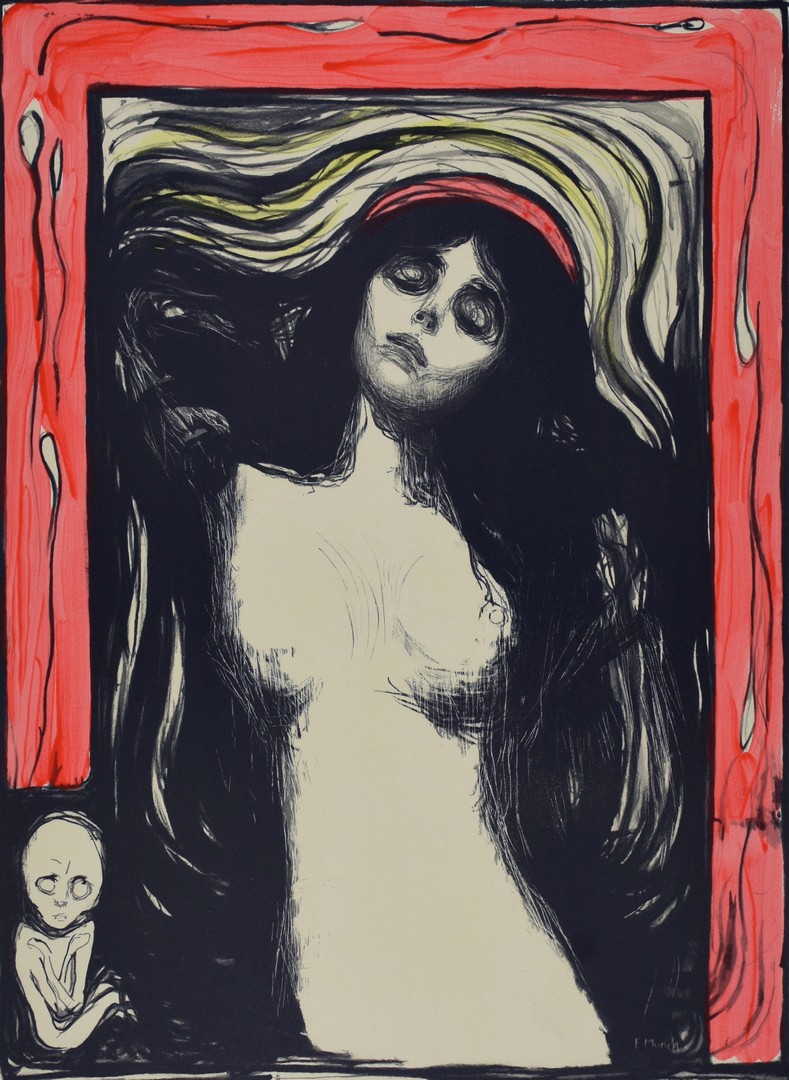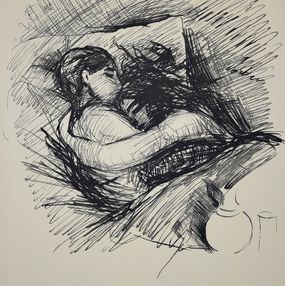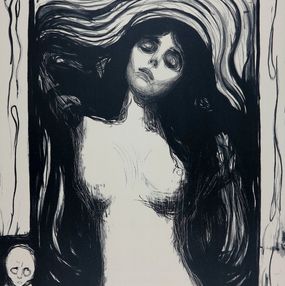
La Madone / Madonna - 1895,
2017
Edvard Munch
Print : lithography
76 x 57 cm 29.9 x 22.4 inch
Free returns within 14 days
Authenticity guaranteed
Learn moreSecure payment
About the artwork
Type
Numbered and limited to 30 copies
1 copy available
Signature
Stamped
Authenticity
Sold with certificate of Authenticity from FRANCE ART DIFFUSION
Invoice from the gallery
Medium
Dimensions cm • inch
76 x 57 cm 29.9 x 22.4 inch Height x Width x Depth
Framing
Not framed
Tags
Artwork sold in perfect condition
Artwork location: France
Hand-Colored lithograph.
Numbered edition at 30 exemplars only.
According to the original lithograph "Madonna" by Edvard Munch dated 1895 of the MUNCH MUSEUM in Oslo (Norway) & for the fist time in the world in reedition.
As it was previously done in 1895, the coloured version has been entirely handmade making each exemplar of this lithograph really unique.
Technique : Lithography
Date of edition : 2017
Publisher: France Art Diffusion
Size : 76 x 57 cm / 29,9 x 22,4 in
Pape r: Velin d'Arches 300g.
Justification: handsigned & numbered in pencil by the lithographer & the publisher.
Dry stamp publisher & the lithography workshop.
Certificate of authenticity.
The very first prints of this lithograph were issued in black and white in Berlin in 1895. Even if the practice of colour printing was tested out in the famous Parisian workshops, it was seldom used in Germany. Therefore, Munch issued his “Madonna” at first in black print on which he added afterwards various colours by hand. By this way, he turned his printings into unique master pieces that were indeed comparable to his paintings.
From the drawing to its printing, these lithographs have been entirely realized by hand. With the same technical and artistic constraints, the same moves are made on the very same period machines. Drawn and printing colour by colour on "Marinoni Voirin" lithographic flat press of 1920.
About the seller
FRANCE ART DIFFUSION • France
Artsper seller since 2015
Vetted Seller
Top Seller
This seller rewards your purchases of multiple artworks
Imagine it at home

Discover more by the artist
Presentation
Born in Løten, Norway, in 1863 and died in Ekely in 1944, Edvard Munch is one of the major artists of the transition between 19th-century Symbolism and 20th-century Expressionism. A painter and printmaker, he is world-renowned for his iconic work The Scream, which has become a universal symbol of modern existential angst.
Coming from a modest family, Munch was deeply affected by the successive bereavements of his mother and sisters. These personal tragedies fuel the recurring themes of his work: illness, death, solitude, destructive love. Very early on, he became interested in painting and trained as an artist in Christiania (now Oslo). He began his studies in naturalist painting before adopting a more personal style, influenced by symbolism and artists like Gauguin .
Since the 1890s, Munch has developed a unique and introspective visual universe. His works express the torments of the human soul with unprecedented emotional force. His stay in Berlin in 1892, where he caused a scandal with an exhibition deemed too audacious, marked a decisive turning point. He then frequented progressive literary and artistic circles, collaborated with Strindberg, and explored engraving, lithography, and woodcuts, mediums he mastered brilliantly.
Among his most famous series, The Frieze of Life embodies his tragic vision of existence, where love, jealousy, fear, and death coexist. He notably painted The Dance of Life and Madonna, works that demonstrate his unique style, combining psychological intensity, stylized composition, and muted colors.
Despite the mental illness that affected him in the 1900s, Munch continued to produce prolifically. He also devoted himself to public commissions, including the monumental frescoes for the University of Oslo. From 1916, he retired to Ekely, where he continued to paint until his death, exploring new subjects, such as the world of work and Norwegian landscapes.
A pioneer of German Expressionism , Munch profoundly influenced artists such as the Die Brücke group. His rich and introspective oeuvre consists of over 1,000 paintings, 15,000 prints, and 4,000 drawings. The Munchmuseet in Oslo preserves most of his legacy.
Today, Edvard Munch remains a pivotal figure in the history of modern art, celebrated through numerous international exhibitions, notably in Paris, Zurich, Berlin, and Frankfurt. His tormented world continues to fascinate, and his works continue to resonate with the questions of our time.
More works from FRANCE ART DIFFUSION
This seller offers discount when you purchase multiple artworks!
Artsper delivers internationally. The list of countries is available in the first step of your cart.
If your country is not listed contact us at [email protected] and we will see what we can do.
Note that Customs fees may apply for works shipped internationally. This is indicated in the first step of the shopping cart.
You can choose a delivery address different from the billing address. Make sure that a trusted person is present to receive the work if you cannot be there.
Have you purchased a painting, sculpture or work on paper?
Find our expert advice for the conservation and promotion of your works in the articles below:
Artsper offers you access to more than 200,000 works of contemporary art from 2,000 partner galleries. Our team of experts carefully selects galleries to guarantee the quality and originality of the works.
You benefit from:
-
Works at gallery price
-
Return within 14 days, regardless of your location
-
Easy resale of the work purchased on Artsper
-
Personalized research tools (selection and tailor-made universe)
Our customer service is available for any assistance.
At Artsper, our mission is to allow you to collect works of art with complete peace of mind. Discover the protections we offer at every stage of your shopping experience.
Buy works from top galleries
We work in close collaboration with carefully selected art galleries. Each seller on Artsper is carefully examined and approved by our team, thus ensuring compliance with our code of ethics. You therefore have the assurance of purchasing authentic, high-quality works.
Total transparency: you know what you are buying
Before being posted online, all artwork on Artsper is reviewed and validated by our moderation team. You can browse with complete peace of mind, knowing that each piece meets our criteria of excellence.
Personalized support: our experts at your service
Our team of contemporary art experts is available by phone or email to answer all your questions. Whether you want advice on a work or a tailor-made selection to enrich your collection, we are here to support you.
Resell your works with ease
If you have purchased a work on Artsper and wish to resell it, we offer you a dedicated platform to relist it. To find out more, click here.
Make offers with Artsper: negotiate like in a gallery
You have the possibility to propose a price for certain works, just like in a gallery. This feature allows you to initiate discussions and potentially acquire your coins at advantageous prices.
Get help with your negotiations
Our team will negotiate for you and inform you as soon as the best offer is obtained. Do not hesitate to call on our expertise to ensure a transaction at the best price.
Order securely
Artsper satisfaction assurance
We want you to be completely satisfied with your purchase. If the work you receive is not to your liking, you have 14 days to return it free of charge, and you will be refunded in full, whatever the reason.
Secure payment with Artsper partners
All credit card payments are processed by Paybox, the world leader in payment solutions. Thanks to their strict security standards, you can transact with confidence.
Problem Support
In the rare event that an artwork arrives damaged or not as described, we are here to help. Whether for a return, refund, restoration or exchange, our team will support you throughout the process and will ensure that we find the solution best suited to your situation.
Conditions to benefit from Artsper protections:
-
Use one of the payment methods available on Artsper for your order.
-
Report any problems within one week of receiving the work.
-
Provide required photographic evidence (including original artwork and packaging).
Artsper guarantees cover the following cases:
-
The received work lacks a described characteristic (for example, a signature or frame).
-
The artwork has significant differences from its description (e.g. color variation).
-
The work is damaged upon receipt.
-
The work is lost or damaged by the carrier.
-
Delivery is significantly delayed.
With Artsper, you collect with complete peace of mind.

















